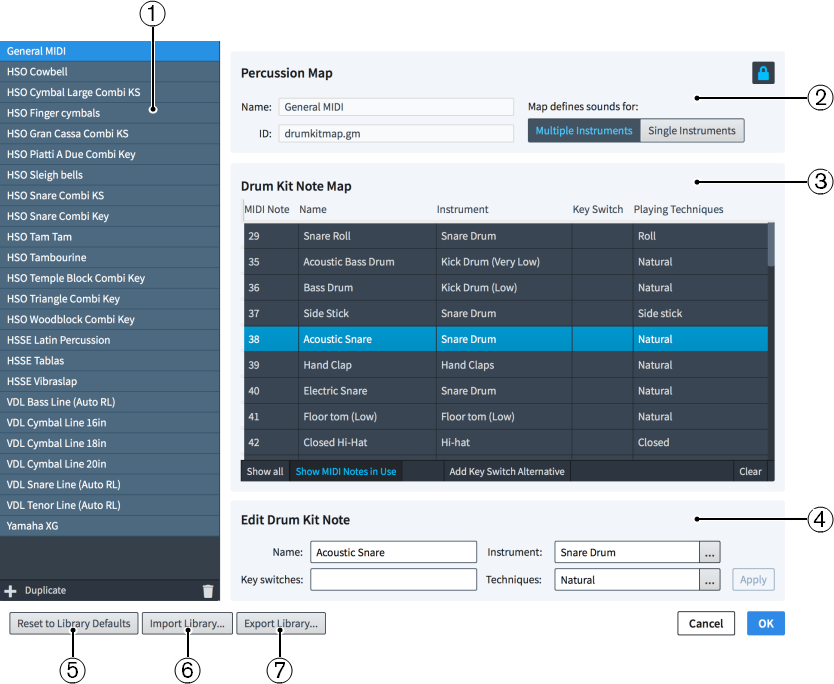Percussion Maps dialog
In the Percussion Maps dialog, you can define custom percussion maps for third-party sound libraries or MIDI devices in order to obtain correct playback.
-
You can open the Percussion Maps dialog in Play mode by choosing .

Figure: Percussion Maps dialog
The Percussion Maps dialog is divided into the following sections:
-
Percussion maps list
Contains the percussion maps currently available in your project.
You can add and delete percussion maps using the following buttons in the action bar at the bottom of the Percussion Maps list:
-
Add Percussion Map

Allows you to add a new percussion map that contains no existing settings.
-
Duplicate
Creates a copy of an existing percussion map that you can edit separately from the original.
-
Delete Percussion Map

Allows you to delete the selected percussion maps.
NoteYou can only delete custom percussion maps. You cannot delete any default percussion maps.
-
-
Percussion Map section
Allows you to specify the following identifying information for the selected percussion map:
-
Name
Allows you to specify the displayed name for the percussion map that appears in the Endpoint Setup dialog.
-
ID
Allows you to set the unique ID of the percussion map. You can enter any content in the ID field.
It can be useful to include the instrument and sound library for which you created the map, as well as your name, for example, xmap.user.paulsmith.hso.cowbell.
NoteThe Endpoint Setup dialog is where you set which percussion map Dorico Pro uses for each channel on your VST instrument or MIDI output device.
You can choose one of the options for Map defines sounds for, as appropriate for the current percussion map:
-
Multiple Instruments
Choose this if the patch for which you are creating a map contains many different percussion instruments, such as the General MIDI drum map.
-
Single Instruments
Choose this if the patch for which you are creating a map contains only a single percussion instrument, perhaps with multiple playing techniques for that instrument. For example, a snare drumline patch in Virtual Drumline or another specialist sample library.
This can also be useful when your VST instrument has several patches that have the same technique mappings. For example, there are both large and small cymbal patches in HALion Symphonic Orchestra which provide natural strike and roll sounds. Creating a single individual instrument percussion map allows you to use the same mapping for these sounds for multiple patches.
-
-
Drum Kit Note Map section
Lists all MIDI notes from 0 to 127. You can specify which combination of unpitched instrument and playing technique is produced by each note.
-
Edit Drum Kit Note section
Allows you to specify data in the following fields for the MIDI note selected in the Drum Kit Note Map section:
-
Name
The displayed name for the specific combination of instrument and technique. You may choose to input the name used in the manufacturer’s documentation for your VST instrument or MIDI output device.
-
Instrument
Allows you to select an instrument for the MIDI note selected in the Drum Kit Note Map section from a list of all the unpitched percussion instruments you can create in Dorico Pro.
-
Techniques
Allows you to select a playing technique to apply to the instrument selected in the Instrument field from a list of all the playing techniques you can create in Dorico Pro.
-
Key switches
Allows you to specify the MIDI note number of the key you want to use as a key switch if this sound requires another MIDI note to be played to trigger this specific combination of instrument and playing techniques.
NoteKey switches are not compulsory.
-
-
Reset to Library Defaults
Allows you to revert any changes you have made to the percussion maps from the Default Library.
-
Import Library
Allows you to import percussion maps from .doricolib files.
-
Export Library
Allows you to select multiple percussion maps and export them into a .doricolib file, which you can import into other projects and share with other users.